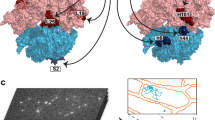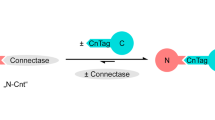Abstract
In vitro translation is a widely used tool for both analytical and preparative purposes. For analytical purposes, small amounts of proteins are synthesized and visualized by detection of labeled amino acids incorporated during translation. The original strategy of incorporating radioactively labeled amino acids, such as [35S]methionine or [14C]leucine, has been superseded by the addition of antigenic tags or the incorporation of biotin-labeled or BODIPY-FL–labeled amino acids. Such nonradioactive tags are easier to visualize after translation and do not pose a radiation hazard. Among the nonradioactive tags, BODIPY-FL–lysine offers the advantage that proteins that have incorporated this amino acid can be directly visualized after gel electrophoresis. We show here that multiple fluorophores introduced into proteins can considerably extend their usefulness, particularly for the comparison of in vitro–translated proteins from related sources. This technology can be applied in various situations, including the simplified detection of rare truncating mutations in clinical samples from cancer patients.
This is a preview of subscription content, access via your institution
Access options
Subscribe to this journal
Receive 12 print issues and online access
$209.00 per year
only $17.42 per issue
Buy this article
- Purchase on Springer Link
- Instant access to full article PDF
Prices may be subject to local taxes which are calculated during checkout



Similar content being viewed by others
References
Tsao, J. & Shibata, D. Further evidence that one of the earliest alterations in colorectal carcinogenesis involves APC. Am. J. Pathol. 145, 531–534 (1994).
Kinzler, K.W. & Vogelstein, B. Lessons from hereditary colon cancer. Cell 87, 159–170 (1996).
Boland, C.R. Genetic pathways to colorectal cancer. Hosp. Pract. 32, 79–84, 87–96 (1997).
Laurent-Puig, P., Beroud, C. & Soussi, T. APC gene: database of germline and somatic mutations in human tumors and cell lines. Nucleic Acids Res. 26, 269–270 (1998).
Traverso, G. et al. Detection of APC mutations in fecal DNA from patients with colorectal tumors. N. Engl. J. Med. 346, 311–320 (2002).
Gite, S., Mamaev, S., Olejnik, J. & Rothschild, K. Ultrasensitive fluorescence-based detection of nascent proteins in gels. Anal. Biochem. 279, 218–225 (2000).
Gite, S. et al. A high-throughput nonisotopic protein truncation test. Nat. Biotechnol. 21, 194–197 (2003).
Powell, S.M. et al. Molecular diagnosis of familial adenomatous polyposis. N. Engl. J. Med. 329, 1982–1987 (1993).
van der Luijt, R. et al. Rapid detection of translation-terminating mutations at the adenomatous polyposis coli (APC) gene by direct protein truncation test. Genomics 20, 1–4 (1994).
Johnson, A.E., Woodward, W.R., Herbert, E. & Menninger, J.R. Nε-acetyllysine transfer ribonucleic acid: a biologically active analogue of aminoacyl transfer ribonucleic acids. Biochemistry 15, 569–575 (1976).
Gorlich, D., Kurzchalia, T.V., Wiedmann, M. & Rapoport, T.A. Probing the molecular environment of translocating polypeptide chains by cross-linking. Methods Cell Biol. 34, 241–262 (1991).
Kobs, G., Hurst, R., Betz, N. & Godat, R. FluoroTect™ GreenLys in vitro Translation Labeling System. Promega Notes 77, 23–27 (2001).
Acknowledgements
We thank Dan Simpson and Dipayan Chaudhuri for expert technical assistance. G.T. is a recipient of a Junior Research Fellowship from Trinity College, Cambridge, UK. This work was supported by the National Colorectal Cancer Research Alliance, by the Caroline Law Fund, by the University of Texas M.D. Anderson Cancer Center, by the Clayton Fund, and by grants (CA 62924, CA 43460, CA 573345 and GM 07184) from the US National Institutes of Health.
Author information
Authors and Affiliations
Corresponding author
Ethics declarations
Competing interests
Under agreements between the Johns Hopkins University and Exact Sciences, Inc., Genzyme Molecular Oncology, Inc. (Genzyme) and Hoffmann-LaRoche, Inc., G.T., K.W.K. and B.V. are entitled to a share of the royalties received by the university on sales of products related to the use of in vitro translation or stool DNA for cancer diagnosis. K.W.K. receives research funding from Genzyme and is a consultant to Exact Sciences and Genzyme. The university, K.W.K. and B.V. also own stock in Genzyme, which is subject to certain restrictions under university policy. The terms of these arrangements are being managed by the university in accordance with its conflict-of-interest policies. B.L. serves on the Scientific Advisory Board of Enterix and receives research support from Pfizer.
Rights and permissions
About this article
Cite this article
Traverso, G., Diehl, F., Hurst, R. et al. Multicolor in vitro translation. Nat Biotechnol 21, 1093–1097 (2003). https://doi.org/10.1038/nbt857
Received:
Accepted:
Published:
Issue Date:
DOI: https://doi.org/10.1038/nbt857



